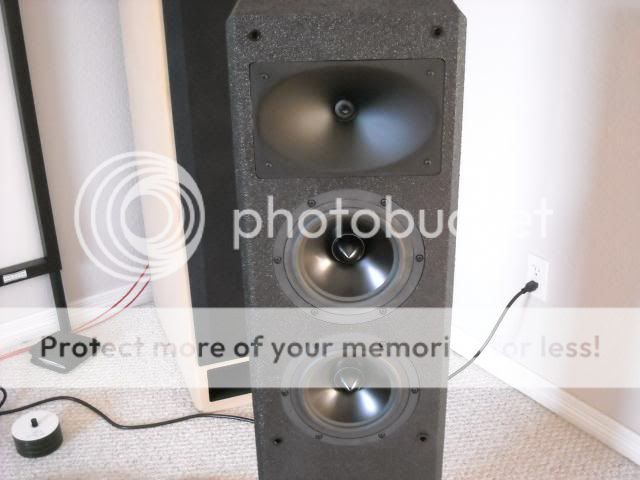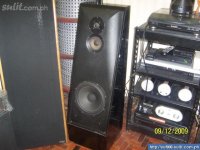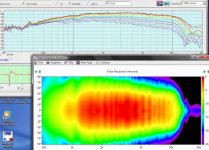I want to use some 4 ohm XT25 tweeters ( http://www.troelsgravesen.dk/PL18XT_files/XT25TG.pdf ) in an active setup with a Elan Z-660 amp, but the amp is rated for 8 ohms min.
How strict is this? Most 8 ohm drivers dip below 8 ohms.
Should I use resistors to make the impedance higher or just use an 8 ohm Wavecor tweeter instead?
http://solen.ca/pdf/wavecor/TW030WA05_06_07_08.pdf
I kind of hate the thought of using resistors on an active setup.
How strict is this? Most 8 ohm drivers dip below 8 ohms.
Should I use resistors to make the impedance higher or just use an 8 ohm Wavecor tweeter instead?
http://solen.ca/pdf/wavecor/TW030WA05_06_07_08.pdf
I kind of hate the thought of using resistors on an active setup.
http://rickgratz.com/examples/z-im-z660.pdf
This is the link to the operating manual. It does state repeatedly that there must be 8 ohms minimum at all times on every connected output. As you say, very few speakers or drivers are actually 8 ohms or stay above 8 ohms. Even stranger is the ability to bridge outputs into 8 ohms which infers that 4 ohms is alright.
Very odd.
This is the link to the operating manual. It does state repeatedly that there must be 8 ohms minimum at all times on every connected output. As you say, very few speakers or drivers are actually 8 ohms or stay above 8 ohms. Even stranger is the ability to bridge outputs into 8 ohms which infers that 4 ohms is alright.
Very odd.
Aren't you forgetting that you need six amps in order to have three bridged circuits?there are only 3 bridged circuits available for 6 amps...makes sense?
I need to use all 6 channels, I think.
I could use another amp for the woofers but I want just the one amp for two 3-way speakers.
I really wanted to use the Vifa tweeter, but without resistors I don't see how.
The Wavecor might be better anyway.
I need really good off-axis response from this system, so an x-over point of 2 KHz would be good even though I'm using a 50 cm^2 midrange.
I could use another amp for the woofers but I want just the one amp for two 3-way speakers.
I really wanted to use the Vifa tweeter, but without resistors I don't see how.
The Wavecor might be better anyway.
I need really good off-axis response from this system, so an x-over point of 2 KHz would be good even though I'm using a 50 cm^2 midrange.
Music varely rarely hits peak power in the treble region. So, if you wanted to use a 4 ohm tweeter in a fullrange speaker connected to an 8 ohm amp, I'd say "sure, don't worry about it"
In an active setup, it's a little trickier. Now, the amp can't really know how many ohms the load is. A 4 ohm load will just draw more current, and it will be like an 8 ohm load at a higher volume setting. Yawn, no biggie...until you get near clipping.
So you'd have to guesstimate if you will be driving the treble channels anywhere near clipping. If not, the 4 ohms will be fine. If you're not sure how to guesstimate, post more details about the whole system and we can try and figure that out.
In an active setup, it's a little trickier. Now, the amp can't really know how many ohms the load is. A 4 ohm load will just draw more current, and it will be like an 8 ohm load at a higher volume setting. Yawn, no biggie...until you get near clipping.
So you'd have to guesstimate if you will be driving the treble channels anywhere near clipping. If not, the 4 ohms will be fine. If you're not sure how to guesstimate, post more details about the whole system and we can try and figure that out.
Jimmy,
Since the tweeter is 4 ohms, it will draw more current and for the same volume setting use more power, ie, play louder. I suggest turning down the amp used for the tweeter when first hooked up, play white and pink noise and turn up the volume until tweeter output equals that of the mid and woofer.
Alternatively, you might want to post in the Solid State forum, asking specifically about using that amp with 4 ohms.
Since the tweeter is 4 ohms, it will draw more current and for the same volume setting use more power, ie, play louder. I suggest turning down the amp used for the tweeter when first hooked up, play white and pink noise and turn up the volume until tweeter output equals that of the mid and woofer.
Alternatively, you might want to post in the Solid State forum, asking specifically about using that amp with 4 ohms.
Six speaker outs on the back looks like six amps to me.
Took a very close look
I now agree.
They can drive 4R but the manual warns about shutdown.
I don't know what they do about bridging...maybe a lower supply tap.
The upside is that actual amp power to an active tweeter isnt like a passive system. I doubt it will ever be asked of even 3 or 4 watts since active amps are denied the lower frequencies as how they cross where passive systems are making the amp produce full freq power and shunting it. I think it would be fine. In my active system, The subs get an actual 8000watts (2-peavey 4080hz's) and clip before the 600w to the mids. The tweeter amp never even has lights blinking for the -10db level....same model amp as the mids which is at -3db when the sub amps clip.
If you use a cap on the tweeter as you should to protect against DC, your impedance under the tweeter's cross freq will be essentially an open loop. If you use a waveguide on the XT25 with a cap to get you back to flat, with a 4.0 -4.7 cap the impedance will be rising below 8K hz. One octave higher at 16K hz, there is very little music info so little signal is produced. You're fine.
If you use a cap on the tweeter as you should to protect against DC, your impedance under the tweeter's cross freq will be essentially an open loop. If you use a waveguide on the XT25 with a cap to get you back to flat, with a 4.0 -4.7 cap the impedance will be rising below 8K hz. One octave higher at 16K hz, there is very little music info so little signal is produced. You're fine.
Last edited:
I need really good off-axis response from this system, so an x-over point of 2 KHz would be good even though I'm using a 50 cm^2 midrange.
A waveguide gets you perfect off axis response to 40 degrees and the cap needed to flatten the low end response of the lift created by the wave guide would be a 4.0 cap and starts raising the impedance below 8K hz.
Bare tweeter
An externally hosted image should be here but it was not working when we last tested it.
With wave guide
An externally hosted image should be here but it was not working when we last tested it.
Last edited:
Sounds like I should put a cap in anyway then, yes?
I won't be using a waveguide, since there is no room.
I'm putting some drivers in an old Thiel CS3.5 and running it active off of my computer.
The speaker will be on the floor on either side of my desk.
The woofers will be similar to Usher 1001B(A), but kind of different from each other and prototypes, lol -- I can change them later easily the cutout is a common size.
Mids will be Wavecor WF120 drivers: https://www.solen.ca/pdf/wavecor/WF120BD03_04.pdf
I was going to do Wavecor tweeters or Vifa XT25 tweeters.
I don't notice much difference on the high end between the two.
The Wavecor has more low end for sure and is much more efficient although they are rated the same I think. Vifa XT25 might have a better high end but it is hard for me to tell. But I like the way it looks much better lol -- I mostly go by looks
I won't be using a waveguide, since there is no room.
I'm putting some drivers in an old Thiel CS3.5 and running it active off of my computer.
The speaker will be on the floor on either side of my desk.
The woofers will be similar to Usher 1001B(A), but kind of different from each other and prototypes, lol -- I can change them later easily the cutout is a common size.
Mids will be Wavecor WF120 drivers: https://www.solen.ca/pdf/wavecor/WF120BD03_04.pdf
I was going to do Wavecor tweeters or Vifa XT25 tweeters.
I don't notice much difference on the high end between the two.
The Wavecor has more low end for sure and is much more efficient although they are rated the same I think. Vifa XT25 might have a better high end but it is hard for me to tell. But I like the way it looks much better lol -- I mostly go by looks

Attachments
Sounds like I should put a cap in anyway then, yes?
I won't be using a waveguide, since there is no room.
I'm putting some drivers in an old Thiel CS3.5 and running it active off of my computer.
The speaker will be on the floor on either side of my desk.
The woofers will be similar to Usher 1001B(A), but kind of different from each other and prototypes, lol -- I can change them later easily the cutout is a common size.
Mids will be Wavecor WF120 drivers: https://www.solen.ca/pdf/wavecor/WF120BD03_04.pdf
I was going to do Wavecor tweeters or Vifa XT25 tweeters.
I don't notice much difference on the high end between the two.
The Wavecor has more low end for sure and is much more efficient although they are rated the same I think. Vifa XT25 might have a better high end but it is hard for me to tell. But I like the way it looks much better lol -- I mostly go by looks
The smaller the cap the higher up you will start you rise in impedance. That mid's ceter to center spacing will likely allow a 2800hz cross so use a cap at 2000 and have the active cross at 2800hz. A 18 to 20 cap is about right as the post before mine suggested. Your impedance from 2000hz down will be far above 4 ohms the whole way and the amp will only be called upon for a few watts which it likely could make into 1 ohm.
I guess I will use the Vifa XT25 then and the 20 uF cap.
I was thinking of maybe still using the Wavecor though because I might want to cross-over at 2 KHz or so to get really good off-axis response from the mid, but I don't know if this is necessary.
I can be more flexible with my x-over slopes too and I don't have to worry about straining the tweeter.
I was thinking of maybe still using the Wavecor though because I might want to cross-over at 2 KHz or so to get really good off-axis response from the mid, but I don't know if this is necessary.
I can be more flexible with my x-over slopes too and I don't have to worry about straining the tweeter.
...I want just the one amp for two 3-way speakers...an x-over point of 2 KHz...
In that case, the amp feeding the tweeter will be nowhere near maximum current output. So don't use resistors, don't series two tweeters (you don't ever really want to series drivers, because the resonances never match exactly so the voltage doesn't divide correctly).
I once presented an AES paper about power transfer through crossover networks, and at 2 kHz crossover in the nowhere-near-real-world case of pink noise, 1/3 of the total power would hit the tweeter. I don't have my preprint handy, but with music it will be WAY less in RMS terms.
SO, just connect the tweeter to the amp and don't worry about it at all. It will be fine.
Last edited:
Just to add a real world example, I am driving 2 RS270-8 on an 18" by 48" OB with a Teac A700 that is only rated to 6 ohms. Its a 3 way
I can make my ears ring with the power, and I have never noticed it current limit, and I am boosting the low end in kind of a worst case scenario.
Do it and do not give it a second thought.
HTH
Doug
I can make my ears ring with the power, and I have never noticed it current limit, and I am boosting the low end in kind of a worst case scenario.
Do it and do not give it a second thought.
HTH
Doug
A waveguide gets you perfect off axis response to 40 degrees and the cap needed to flatten the low end response of the lift created by the wave guide would be a 4.0 cap and starts raising the impedance below 8K hz.
Bare tweeter

With wave guide

I like the waveguide idea, but unfortunately the boost a tweeter gets at one listening position from a waveguide comes from the off-axis SPL drop, which exactly what I want to avoid. Also I want the tweeter and mid fairly close.
This is illustrated really well in your polar response of an 8 inch diameter waveguide, is it?
Also I've never heard one, so it would not be good if I built it and didn't like it.
In one thread some one called it harsh, then some one else called it harsh, but maybe just forwardness that sounded like harshness to increased power response, perhaps, I forget. And then one guy said he couldn't make the tweeter "'disappear'". All of those things make me not want to try it.
But I was reading Zaph's write-up about tweeters and I agree that it's most important a tweeter or any driver work best in it's lowest range or application for obvious reasons.
I've always liked the idea of 30 mm or bigger tweeter.
If I were to put anything around the tweeter it would actually have the opposite function of a waveguide

It would boost the off-axis FR. Perhaps some sort of reverse waveguide
I like the Seas 27TBFCG tweeter, that one would be best for my purpose, since it has a phase shield that gives it great off-axis FR.
Attachments
Last edited:
Moving around with the mic I see nothing that supports your statement.
In addition, the point of the WG's low cross invalidates the importance of center to center distance. Anyway, in this case, the eliptical WG allows a very close distance because its only 5" tall increasing the distance by only a 1/2" over a 4" bare tweeter.

In addition, the point of the WG's low cross invalidates the importance of center to center distance. Anyway, in this case, the eliptical WG allows a very close distance because its only 5" tall increasing the distance by only a 1/2" over a 4" bare tweeter.

- Status
- This old topic is closed. If you want to reopen this topic, contact a moderator using the "Report Post" button.
- Home
- Loudspeakers
- Multi-Way
- I want to use 4 ohm Vifa XT25 tweeters with 8 ohm amp

